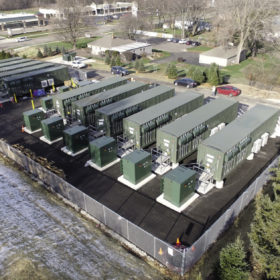
In 2019, the United States will become the world’s largest market for grid-connected battery energy storage, writes IHS Markit’s Camron Barati, as solar-plus-storage and peaking capacity requirements drive increased procurement.
From pv magazine, July edition
Deployments of grid-connected energy storage in the United States are expected to amount to 712 MW this year. This represents a near-doubling from 376 MW in 2018. On the strength of this performance, the United States will surpass South Korea, which will see the market drop below 600 MW, or even significantly lower.
The increasing market activity in the United States is being propelled by significant regulatory and policy developments, such as the Federal Energy Regulatory Commission’s Order 841 — which directed regional grid operators to establish rules allowing energy storage to participate in energy, capacity and ancillary services markets — as well as various state-level policy mandates and the diversification of market applications and geographic activity.
Utility-scale solar+storage
IHS Markit expects over 2 GW of energy storage to be paired with utility-scale PV systems from 2019 to 2023 in the United States. Solar-plus-storage projects will account for over 40% of all front-of-the-meter battery energy storage capacity additions in the United States during this period.
The availability of the Investment Tax Credit (ITC) through 2023 for battery-storage systems coupled with solar PV has spurred development over the past year and will be the primary driver of co-locating utility-scale PV with energy storage. The majority of these systems are projected to be deployed in markets across the western United States, including Hawaii, California and Arizona, enabling the further integration of PV in relatively saturated markets.
In terms of installed PV capacity, 10 GW of utility-scale solar installations are forecast to be paired with energy storage from 2019 to 2023, accounting for 16% of utility-scale PV installations during the period. Demand will be strongest in western markets such as Hawaii, California, and Arizona. Meanwhile, markets outside of the western United States that are equally poised for strong utility-scale PV growth, such as Florida, Virginia and Georgia, have a significantly lower immediate need for co-locating PV with energy storage.
Cost-effective and flexible
Cost synergies and operational efficiencies for pairing the two technologies can provide significant value, but they are overshadowed when comparing the opportunity to reduce the capital costs of energy storage by up to 30% with the ITC. With support building for a separate ITC that would apply to stand-alone energy storage, IHS Markit recognizes that such a policy could significantly reduce demand for co-location projects in the United States.
DC-coupled systems can have a small but significant cost advantage over AC-coupling, depending on system size and characteristics, with the primary benefits including the reduction of power conversion equipment required and the ability to recapture DC energy that would otherwise be clipped by the inverters. AC-coupled systems are generally better suited to flexibly participate in a wider array of ancillary services, while both system types can leverage the ITC and benefit from shared installation and operational costs.
The majority of operational utility-scale solar-plus-storage projects tracked by IHS Markit are associated with PV-to-storage ratios greater than 2:1 — for example, 100 MW of PV paired with 25 MW of energy storage — though a growing portion of projects in the development pipeline are being designed with relatively tight ratios closer to 1:1. Demand for tighter PV-to-storage ratios is especially growing in markets with high penetration of solar, in order to limit energy delivery during midday and meet peak demand as it shifts into later periods between 4 p.m. and 6 p.m.
In terms of the 30-year levelized cost of energy (LCOE), IHS Markit estimates that adding 25 MW / 100 MWh of energy storage to a 100 MW (AC) single-axis tracking PV system in 2019 could increase the pre-ITC cost of energy by 35 to 40%, assuming the battery system is replaced after 15 years. After accounting for installation and operational synergies of DC-coupling and applying the ITC to the cost of both solar and energy storage, an LCOE below $40/MWh can be achieved.
By 2023, IHS Markit forecasts that new utility-scale solar-plus-storage resources in the United States will be able to generate electricity at rates competitive with new natural gas plants. This economic reality, paired with the growing number of state-level initiatives to achieve 100% renewable penetration, illustrates the long-term opportunity for the two technologies to meet the requirements of a transitioning energy system.
Lắp đặt điện mặt trời Khải Minh Tech
https://ift.tt/2X7bF6x
0906633505
info.khaiminhtech@gmail.com
80/39 Trần Quang Diệu, Phường 14, Quận 3
Lắp đặt điện mặt trời Khải Minh Tech
https://ift.tt/2ZH4TRU
Không có nhận xét nào:
Đăng nhận xét